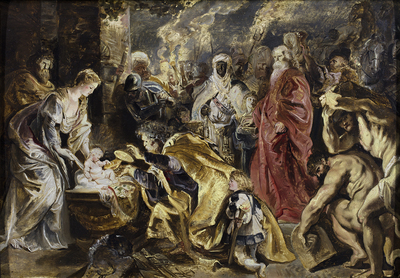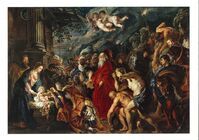Aanbidding der koningen
Objectnummer1931.0121
TitelAanbidding der koningen
Aanbidding der wijzen
Rubensschets
Aanbidding der wijzen
Rubensschets
Vervaardiger Peter Paul Rubens
BeschrijvingOp deze betrekkelijk grote olieverfschets met de Aanbidding der koningen vormen Maria en Jozef het linkerdeel van de compositie. Maria toont het Christuskind aan de geknielde koning, die zijn zwaard heeft afgelegd en wiens mantel wordt opgehouden door een kleurig uitgedoste knaap. De twee andere koningen staan rechts achter hem. Opmerkelijk is dat Rubens er voor koos om een zwarte man (Balthasar) te schilderen als centrale personage in de compositie - iets wat in die tijd erg uitzonderlijk was. De voorstelling wordt aan de rechterzijde afgesloten door twee gespierde dragers. Geheel rechtsboven is de kop van een paard en een kameel voorgesteld. Rubens heeft de scène bij nacht voorgesteld. Achter de hoofdrolspelers staat een groot aantal figuren, sommige met brandende toortsen. Hun fakkels fungeren als lichtbron en verlichten de scène op feeërieke wijze. Het stralend middelpunt van het geheel is het Christuskind. Rubens heeft tijdens het schilderen verschillende veranderingen aangebracht. Zo is een figuur boven het Christuskind weggeschilderd. Zijn hand en fakkel zijn echter blijven staan en zweeft nu in de ruimte. Het werk is met grote vaart en uiterst trefzeker uitgevoerd. In het kleurgebruik overheersen geel, oker en donkerblauw, met de rode mantel van de rechter koning als belangrijk rood accent.
This sketch is a preparatory study in oil for a large canvas "Adoration of the Magi" (La Adoración de los Reyes Magos, 355,5 x 493 cm), 1609, 1628-1629 by Rubens, which is now in the Museo Nacional del Prado in Madrid. Despite the religious theme, the work was not intended to be an altar piece but was meant to be hung in the council-chamber of the States in the city hall in Madrid. This is the room in which the negotiations took place for the Twelve Year Truce between Spain and the northern Netherlands that was concluded in 1609.
When Rubens visited Madrid on a diplomatic mission in 1628-29 he found this painting, which he himself had executed in 1609 for Antwerp city council, and which now belonged to Philip IV’s collection. He made substantial changes to the composition. He added a strip to the top of the scene and another to the right-hand side and adapted the language of the painting to the style he was then using, which was greatly inspired by Titian. He also included a portrait of himself on horseback with gold chain and sword, conveying his noble status. (bron: Museo del Prado)
This sketch is a preparatory study in oil for a large canvas "Adoration of the Magi" (La Adoración de los Reyes Magos, 355,5 x 493 cm), 1609, 1628-1629 by Rubens, which is now in the Museo Nacional del Prado in Madrid. Despite the religious theme, the work was not intended to be an altar piece but was meant to be hung in the council-chamber of the States in the city hall in Madrid. This is the room in which the negotiations took place for the Twelve Year Truce between Spain and the northern Netherlands that was concluded in 1609.
When Rubens visited Madrid on a diplomatic mission in 1628-29 he found this painting, which he himself had executed in 1609 for Antwerp city council, and which now belonged to Philip IV’s collection. He made substantial changes to the composition. He added a strip to the top of the scene and another to the right-hand side and adapted the language of the painting to the style he was then using, which was greatly inspired by Titian. He also included a portrait of himself on horseback with gold chain and sword, conveying his noble status. (bron: Museo del Prado)
Datum circa 1609 - circa 1610
Vervaardiging periode17e eeuw
Objectnaamschilderijen, schetsen (beeldende werken), historiestukken
Objectcategorieschilderijen
Materiaalolieverf, paneel (hout)
Techniekschilderen
Formaat
- hoogte: 54.50 cm
breedte: 76.50 cm
hoogte: 81.00 cm
breedte: 102.00 cm
dikte: 11.50 cm
nieuwe lijst hoogte: 68.50 cm
breedte: 91.00 cm
dikte: 6.50 cm
Credit lineGroninger Museum, Collectie Hofstede de Groot


